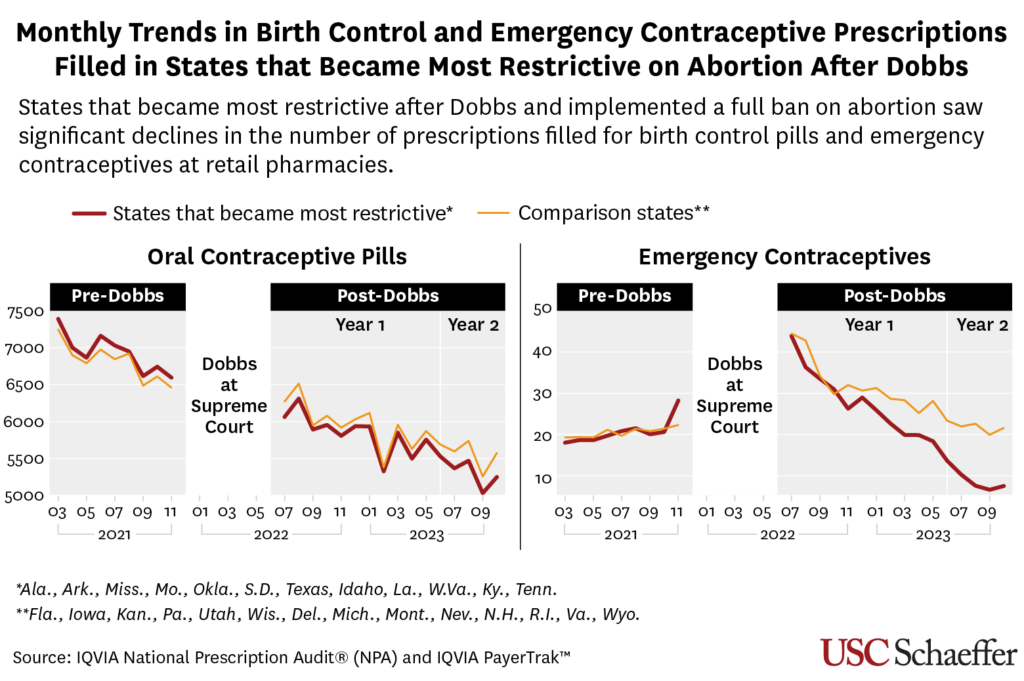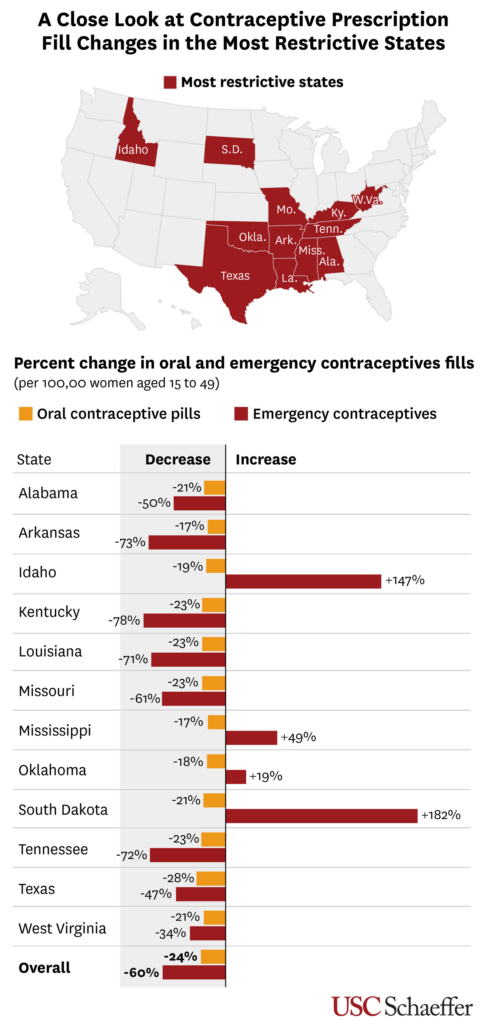Women residing in states with the most restrictive abortion policies after the Supreme Court’s reversalof Roe v Wade also experienced declines in the use of birth control pills and emergency contraceptives, according to a new USC study evaluating the impact of the decision.
The findings, which appear today in JAMA Network Open, suggest that the Dobbs v. Jackson Women’s Health Organization case has had even wider ramifications for women’s reproductive health than previously thought.
The analysis found that states that became that most restrictive after Dobbs, implementing a full ban on abortion, saw significant declines in the number of prescriptions filled for birth control pills and emergency contraceptives at retail pharmacies. These reductions weren’t observed in restrictive states whose policies were unchanged after the Dobbs decision.

Many family planning clinics with abortion services closed immediately after the Roe reversal—particularly in the most restrictive states, said lead author Dima M. Qato, senior fellow at the USC Schaeffer Center for Health Policy & Economics.
“Because 11% of women rely on such clinics for the provision of prescriptions for contraceptives – many of which are filled at outside pharmacies – these closures may have reduced access to oral and emergency contraceptives,” Qato said. Qato is also the Hygeia Centennial Chair and associate professor at the USC Mann School of Pharmacy and Pharmaceutical Sciences.
What’s more, the Supreme Court decision may also have contributed to declines in the use of emergency contraceptives due to misunderstandings about their legality. A January 2023 survey by the Kaiser Family Foundation found that half of women in full-ban states believed Plan B was illegal in their state.
This is the first national study to evaluate the impact of the court’s June 24, 2022, Dobbs decision on prescription fills for oral and emergency contraceptives in the United States.
Efforts needed to protect access
Qato led a team which examined changes in the use of prescription birth control pills and emergency contraceptives before and after the Dobbs decision. During the time period analyzed, March 2021 and October 2023, 142.8 million prescriptions for oral contraceptive pills and 904,269 prescriptions for emergency contraceptives were dispensed at U.S. retail pharmacies.

Before Roe’s reversal,trends in monthly prescription rates for oral and emergency contraception were similar between the most restrictive and least restrictive states. Then, while the case was being reviewed, more highly restrictive states saw a spike in emergency contraceptive prescriptions.
After the decision, however, the researchers found that states becoming the most restrictive experienced a 24% total decline in oral contraceptive prescriptions filled. Fills for emergency contraceptives declined by 65% in the most restrictive states compared to less restrictive ones.
“In states such as Texas and Mississippi where women now don’t even have the option to have an abortion, their access to contraception is also becoming more difficult,” said Qato. “More efforts to improve and protect access to oral contraceptives are needed, especially for emergency contraceptives in states where abortion is no longer an option.”
Researchers noted that emergency contraceptive fills post-Dobbs increased the most in Idaho, which, among states with the most restrictive abortion policies, is the only one that allows pharmacists to prescribe emergency contraceptives to women without any age restrictions.
“We saw the greatest declines in birth control pills and emergency contraceptives in states that had closed a larger share of their family planning clinics. In Texas, for example, birth control pill prescriptions declined by 28% and emergency contraceptive fills declined by 48%,” said Rebecca Myerson, a Schaeffer Fellow and assistant professor at UW Madison worked on the study.
About this study
Data for the study came from three sources: IQVIA National Prescription Audit PayerTrak, to estimate the monthly volume of prescriptions dispensed at pharmacies at the national and state level; the 2021 American Community Survey, to determine the total population of women and girls of reproductive age; and the Guttmacher Institute, to classify each state in terms of changes in policies related to abortion restrictions between June 2022 and October 2023.
In addition to Qato and Myerson, other authors include co-author G. Caleb Alexander, professor of epidemiology and medicine at the Johns Hopkins Bloomberg School of Public Health; UC Berkeley assistant professor Jenny S. Guadamuz, a former postdoctoral research fellow at the Schaeffer Center; and USC Mann research affiliate Andrew Shoostari.
Sign up for Schaeffer Center news


You must be logged in to post a comment.